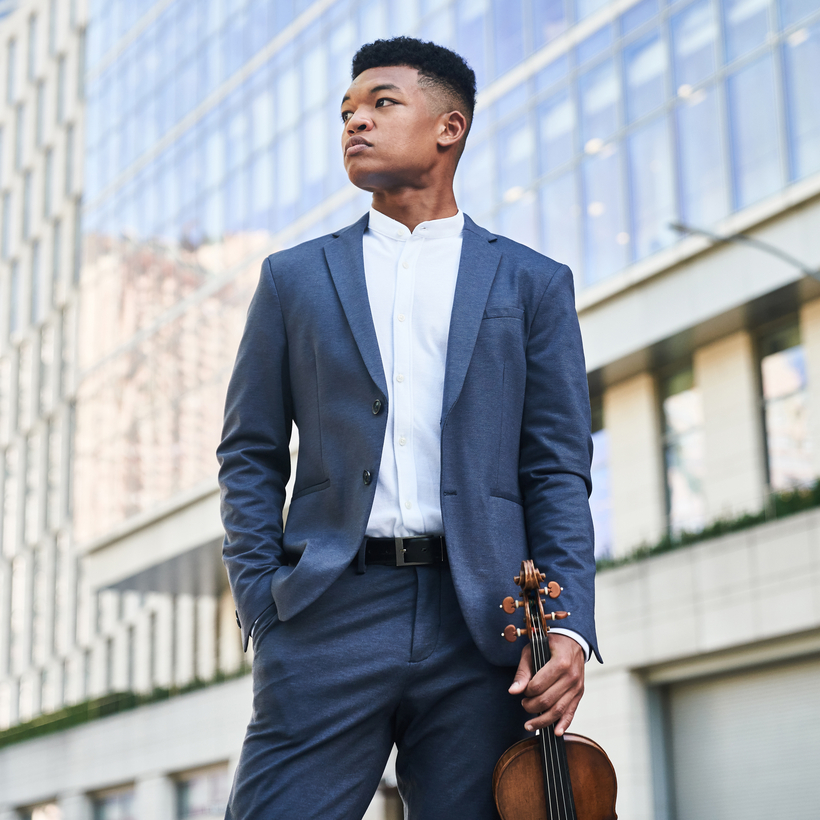“My parents weren’t interested in classical music until I came into the picture,” Randall Goosby says on a Zoom call from New York, a pair of designer specs lending his GQ-ready charisma the studious air of a junior delegate to the U.N. His father, who is Black, had played trombone in his middle-school band. His Korean mother, raised in Japan, had taught herself English by singing pop songs and R&B in college. Yet she decided early on that a child needed an opportunity to express himself. “I’m going to force you to play music,” she told her seven-year-old, “but you can choose your instrument.” After a false start on the piano, Goosby switched to violin and was hooked, though dreams of stardom in football or basketball lingered for a long time.
At 24, the young virtuoso is heading into a breakout summer. Next week, Decca releases his debut album, Roots, which concentrates on Black American composers, male and female. Rounding out the program is a sonatina by Antonín Dvořák, written in New York City under the spell of American Indian melodies and the songs of enslaved Africans, plus concert arrangements of songs from Gershwin’s Porgy and Bess. Throughout, Goosby combines technical assurance with an expressive freedom that lets the music speak as well as sing; in the Gershwin, the action of bow on string all but voices the words.

Trained at the Juilliard School, at Lincoln Center, where he recently completed his master’s degree on a full scholarship, Goosby was born in San Diego but grew up mostly in Memphis. He began to sense his powers in his early teens, going into public schools to play for other students. At first, such gigs were more nerve-racking than formal appearances on a concert stage. “I looked like a baby,” Goosby remembers. “I’d look out and think, ‘Why would these kids be interested in me, in what I do?’ But I’d tell my story, and then I’d play some Bach and Paganini. And 9 times out of 10, I’d look out and see jaws on the floor. They weren’t used to hearing that music, and certainly not from a kid who looked like me.”
From his mid-teens, Goosby has been blessed with the use of a series of outstanding historic instruments on loan from the Chicago-based Stradivari Society, which exists to serve rising stars in just this way. The moment the custodians of the collection found out about him could not have been more propitious. He was outgrowing the scaled-down violins children learn on, and his mother, never at a loss, had come up with one that was regulation size: a $200 Chinese-factory instrument she scored on eBay.
“I thought that instrument was the coolest thing,” Goosby remembers. “It was my first full-size violin!” But when he brought it to his next lesson, his teacher, the Russian-trained concert artist Philippe Quint, could hardly believe his ears. “What’s this?,” Quint demanded. “A chair with strings? We could buy a kit at Ikea and make a better violin.” Himself a beneficiary of the Stradivari Society’s lending program, Quint placed a call to Chicago on Goosby’s behalf, and the eBay wonder got stashed in a closet, never to be seen or touched again. These days, Goosby is heard on the Giuseppe Guarneri del Gesù, known as the “Sennhauser,” built in 1735.
“Violins have personalities, like sentient beings,” Goosby says. “Each one wants to be played in a certain way. I love all the instruments the Stradivari Society has loaned me. But I’ve just never had an instrument of this quality before. I don’t know how long I can keep it, and I won’t think about that now. The first time I played it, it gave me chills. Such power and poise. It could do anything. We’ve learned a lot about each other. I’ve fondly named it ‘LeBron.’”
Matthew Gurewitsch writes about opera and classical music for AIR MAIL. He lives in Hawaii


 Discover
Discover